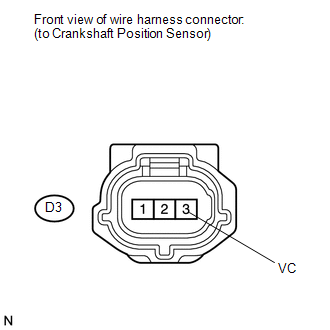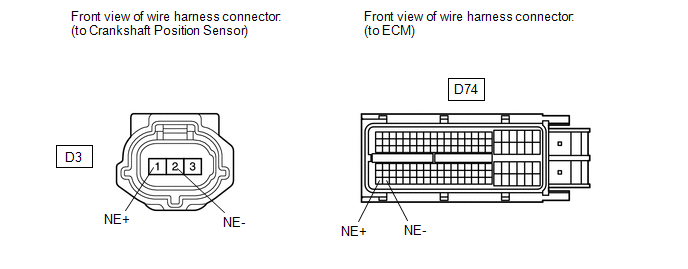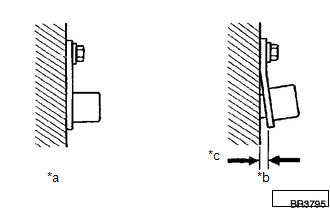DESCRIPTION The crankshaft
position (CKP) sensor system consists of a crankshaft angle sensor plate
and Magnetoresistive Element (MRE) type sensor. The crankshaft angle
sensor plate has 34 teeth at 10° intervals (2 teeth are missing for
detecting top dead center), and is installed to the rear end of the
crankshaft. The crankshaft position sensor outputs 34 rotation signals
per crankshaft revolution. The ECM uses the G2 signal to distinguish
between the cylinders, and uses the NE signal to detect the crankshaft
position and engine rpm. |
DTC No. | DTC Detection Condition |
Trouble Area | | P0335 |
Either condition is met:
- No crankshaft position (CKP) sensor signal to ECM while cranking (1 trip detection logic)
- No crankshaft position (CKP) sensor signal to ECM at engine speed of 450 rpm or more (1 trip detection logic)
|
- Open or short in crankshaft position (CKP) sensor circuit
- Crankshaft position (CKP) sensor
- Crankshaft position (CKP) sensor plate
- ECM
| | P0337 |
Output voltage of CKP sensor 0.3 V or less for 4 seconds (1 trip detection logic) |
- Open or short in CKP sensor circuit
- CKP sensor
- CKP sensor plate
- ECM
| | P0338 |
Output voltage of CKP sensor 4.7 V or more for 4 seconds (1 trip detection logic) |
- Open or short in CKP sensor circuit
- CKP sensor
- CKP sensor plate
- ECM
| | P0339 |
Under conditions (a), (b) and (c), no CKP sensor signal to ECM for 0.05 seconds or more (1 trip detection logic):
(a) Engine speed 1000 rpm or more (b) Starter signal OFF
(c) 3 seconds or more have elapsed since starter signal switched from ON to OFF |
- Open or short in CKP sensor circuit
- CKP sensor
- CKP sensor plate
- ECM
|
MONITOR DESCRIPTION If
there is no signal from the crankshaft position sensor despite the
crankshaft revolving, the ECM interprets this as a malfunction of the
sensor. When the sensor output voltage remains at less than 0.3 V, or more than 4.7 V for more than 4 seconds, the ECM stores a DTC. MONITOR STRATEGY |
Related DTCs | P0335: Crankshaft position sensor range check/rationality
P0337: Crankshaft position sensor check (Low voltage) P0338: Crankshaft position sensor check (High voltage) | |
Required sensors/Components (Main) | Crankshaft Position (CKP) sensor | |
Required sensors/Components (Related) |
Camshaft position sensor | |
Frequency of operation | Continuous | |
Duration | P0335: 4.7 seconds P0337, P0338: 4 seconds | |
MIL operation | Immediate | |
Sequence of operation | None | TYPICAL ENABLING CONDITIONS ALL |
Monitor runs whenever following DTCs not present |
None | P0335: Crankshaft Position Sensor Range Check Case 1 |
Engine speed (Top dead center) | 450 rpm or more | |
Engine speed (30°CA) | 450 rpm or more | |
Starter | OFF | |
Time after starter turned from ON to OFF |
3 seconds or more | | CKP sensor voltage |
0.3 to 4.7 V | Case 2 |
Starter | ON | |
Minimum battery voltage while starter ON |
Below 11 V | | CKP sensor voltage |
0.3 to 4.7 V | P0337, P0338 Crankshaft Position Sensor Range Check (Low Voltage, High Voltage) |
Battery voltage | 8 V or higher | |
Ignition switch | ON | |
Starter | OFF | TYPICAL MALFUNCTION THRESHOLDS P0335 Crankshaft Position Sensor Range Check |
Engine speed signal | No signal | P0337 Crankshaft Position Sensor Range Check (Low Voltage) |
CKP sensor voltage | Less than 0.3 V | P0338 Crankshaft Position Sensor Range Check (High Voltage) |
CKP sensor voltage | More than 4.7 V | COMPONENT OPERATING RANGE |
CKP sensor |
- CKP sensor output voltage fluctuates while engine crankshaft revolving
- 34 CKP sensor signals per crankshaft revolution
| | CKP sensor voltage |
0.3 to 4.7 V | CONFIRMATION DRIVING PATTERN
- Connect the Techstream to the DLC3.
- Turn the ignition switch to ON and turn the Techstream on.
- Clear DTCs (even if no DTCs are stored, perform the clear DTC operation).
- Turn the ignition switch off and wait for at least 30 seconds.
- Turn the ignition switch to ON and turn the Techstream on.
- Start the engine.
- Idle the engine for 20 seconds or more [A].
- Enter the following menus: Powertrain / Engine and ECT / Trouble Codes [B].
- Read the pending DTCs.
HINT:
- If a pending DTC is output, the system is malfunctioning.
- If a pending DTC is not output, perform the following procedure.
- Enter the following menus: Powertrain / Engine and ECT / Utility / All Readiness.
- Input the DTC: P0335, P0337 or P0338.
- Check the DTC judgment result.
|
Tester Display |
Description |
|
NORMAL |
- DTC judgment completed
- System normal
|
|
ABNORMAL |
- DTC judgment completed
- System abnormal
|
|
INCOMPLETE |
- DTC judgment not completed
- Perform driving pattern after confirming DTC enabling conditions
|
|
N/A |
- Unable to perform DTC judgment
- Number of DTCs which do not fulfill DTC preconditions has reached ECU memory limit
|
HINT:
If the judgment result shows INCOMPLETE or N/A, perform steps [A] through [B] again.
- If no pending DTC is output, perform a universal trip and check for permanent DTCs (See page
 ). ).
HINT:
- If a permanent DTC is output, the system is malfunctioning.
- If no permanent DTC is output, the system is normal.
WIRING DIAGRAM
 CAUTION / NOTICE / HINT
HINT:
- If no problem is found by this diagnostic troubleshooting procedure,
check for problems by referring to the engine mechanical section.
- The engine speed can be checked by using the Techstream. To perform the check, follow the procedures below:
- Connect the Techstream to the DLC3.
- Start the engine.
- Turn the Techstream on.
- Enter the following menus: Powertrain / Engine and ECT / Data List / Engine Speed.
- The engine speed may be indicated as zero despite the engine running
normally. This is caused by a lack of NE signals from the crankshaft
position (CKP) sensor. Alternatively, the engine speed may be indicated
as lower than the actual engine speed if the CKP sensor output voltage
is insufficient.
- Read freeze frame data using the Techstream. Freeze frame data records
the engine conditions when malfunctions are detected. When
troubleshooting, freeze frame data can help determine if the vehicle was
moving or stationary, if the engine was warmed up or not, if the
air-fuel ratio was lean or rich, and other data from the time the
malfunction occurred.
PROCEDURE |
1. | READ VALUE USING TECHSTREAM (ENGINE SPEED) |
(a) Connect the Techstream to the DLC3. (b) Turn the ignition switch to ON.
(c) Turn the Techstream on. (d) Enter the following menus: Powertrain / Engine and ECT / Data List / Engine Speed.
(e) Start the engine. (f) Read the values displayed on the Techstream while the engine is running.
Standard: Correct values are displayed.
HINT:
- To check the engine speed change, display the graph on the Techstream.
- If the engine does not start, check the engine speed while cranking.
- If the engine speed indicated on the Techstream remains zero (0), there
may be an open or short in the Crankshaft Position (CKP) sensor circuit.
| OK |
 | CHECK FOR INTERMITTENT PROBLEMS |
|
NG |
 | |
| 2. |
INSPECT CRANKSHAFT POSITION SENSOR (SENSOR POWER SOURCE) |
 (a) Disconnect the crankshaft position sensor connector.
(b) Measure the voltage according to the value(s) in the table below. Standard Voltage: |
Tester Connection | Switch Condition |
Specified Condition | |
D3-3 (VC) - Body ground |
Ignition switch ON | 4.5 to 5.0 V |
| NG |
 | GO TO STEP 8 |
|
OK |
 | |
| 3. |
CHECK HARNESS AND CONNECTOR (CRANKSHAFT POSITION SENSOR - ECM) |
 (a) Disconnect the crankshaft position sensor connector.
(b) Disconnect the ECM connector. (c) Measure the resistance according to the value(s) in the table below.
Standard Resistance: |
Tester Connection | Condition |
Specified Condition | |
D3-1 (NE+) - D74-110 (NE+) |
Always | Below 1 Ω | |
D3-2 (NE-) - D74-111 (NE-) |
Always | Below 1 Ω | |
D3-1 (NE+) or D74-110 (NE+) - Body ground |
Always | 10 kΩ or higher | |
D3-2 (NE-) or D74-111 (NE-) - Body ground |
Always | 10 kΩ or higher |
| NG |
 | REPAIR OR REPLACE HARNESS OR CONNECTOR |
|
OK |
 | |
| 4. |
CHECK SENSOR INSTALLATION (CRANKSHAFT POSITION SENSOR) |
 (a) Check the crankshaft position sensor installation.
OK: Sensor is installed correctly.
| NG |
 | SECURELY REINSTALL SENSOR |
|
OK |
 | |
| 5. |
INSPECT CRANKSHAFT POSITION SENSOR PLATE (TEETH OF SENSOR PLATE) |
(a) Check the teeth of the sensor plate. OK: Sensor plate does not have any cracks or deformation.
| NG |
 | REPLACE CRANKSHAFT POSITION SENSOR PLATE |
|
OK |
 | |
| 6. |
REPLACE CRANKSHAFT POSITION SENSOR | (a) Replace the crankshaft position sensor (See page
 ). ).
|
NEXT |
 | |
| 7. |
CHECK WHETHER DTC OUTPUT RECURS (DTC P0335, P0337, P0338 AND/OR P0339) |
(a) Connect the Techstream to the DLC3. (b) Turn the ignition switch to ON.
(c) Turn the Techstream on. (d) Clear DTCs (See page
 ). ). (e) Refer to the confirmation driving pattern.
(f) Enter the following menus: Powertrain / Engine and ECT / Trouble Codes.
(g) Read DTCs. Result |
Result | Proceed to | |
No DTC is output | A | |
P0335, P0337, P0338 or P0339 is output |
B | HINT: If the engine does not start, replace the ECM.
| A |
 | END |
| B |
 | REPLACE ECM |
| 8. |
CHECK HARNESS AND CONNECTOR (CRANKSHAFT POSITION SENSOR - ECM) |
 (a) Disconnect the crankshaft position sensor connector.
(b) Disconnect the ECM connector. (c) Measure the resistance according to the value(s) in the table below.
Standard Resistance: |
Tester Connection | Condition |
Specified Condition | |
D3-3 (VC) - D74-66 (VCV2) |
Always | Below 1 Ω | |
D3-3 (VC) or D74-66 (VCV2) - Body ground |
Always | 10 kΩ or higher |
| OK |
 | REPLACE ECM |
| NG |
 | REPAIR OR REPLACE HARNESS OR CONNECTOR | | 



